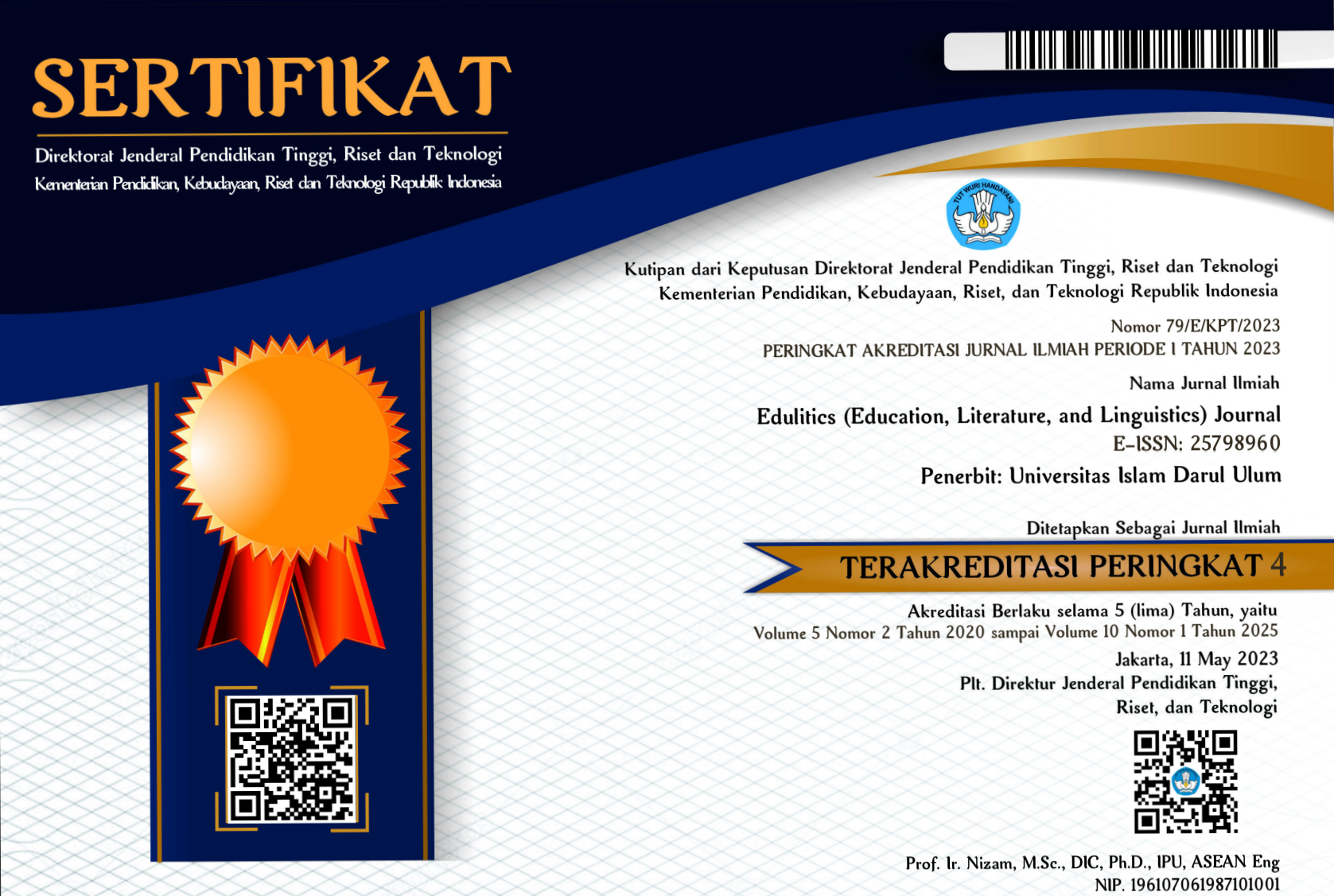Improving Students’ Ability in Writing Descriptive Text Using Example Non-Example Method at Eight Class of SMP Negeri 3 Ngimbang
Abstract
The aim of this research is to know: (1) difference of descriptive writing skill between eighth class of SMP Negeri 3 Ngimbang who follow the learning of writing descriptive text using example non-example method with students who follow the learning of writing descriptive text without using example non-example method, (2) the effectiveness of the use of the example non-example method in learning to write descriptive text in the eighth grade of SMP Negeri 3 Ngimbang. This research is a quasi-experimental research using pretest-posttest control group design. The results of t-test calculations performed on the post-test scores between the control group and the experimental group showed that the t-count was 2.735 with db 48 and Sig. (2-tailed) 0.009. Sig value. (2-tailed) which is 0.009 is smaller than the significance level of 5% (0.009 <0.050). This shows that there is a significant difference of descriptive writing skill among eight grade students of SMP Negeri 3 Ngimbang who follow the learning of descriptive text writing using example non-example method with students who follow poetry writing lesson without using example non-example method. After the pre-test and post-test test of each group, it is seen that the difference of pre-test score and post-test score in the experimental group is larger than the control group (4.6> 2.52). This shows that the non-example example method is effectively used in writing descriptive text writing of eighth graders of SMP Negeri 3 Ngimbang.
Downloads
References
Arikunto, S. (2010). Prosedur Penelitian: Suatu Pendekatan Praktik. Jakarta: Rineka Cipta.
Cahyono, B. Y. (2010). The Teaching of English Language Skills and English Language Components. Malang: State University of Malang Press.
Haris, D. P. (1969). Testing English as a Second Language. New York: Mc Graw-Hill Book Company.
Huda, M. (2013). Model-Model Pengajaran dan Pembelajaran. Yogyakarta: Pustaka Pelajar.
Istarani. (2012). 58 Model Pembelajaran Inovatif. Medan: Media Persada.
Khulel, B. (2022). Improving students’ writing skill through project-based learning, process writing, and Instagram. IJECA (International Journal of Education and Curriculum Application), 5(1), 25-35.
Kusuma, A. (2014). Keefektifan Penggunaan Model Contoh Non-Contoh (Example Non-Example) Dalam Pembelajaran Menulis Puisi Pada Siswa Kelas X Man Tempel Sleman.Skripsi. Jurusan Pendidikan Bahasa dan Sastra Indonesia, FBS, UNY.
Nurgiyantoro, Burhan, Gunawan, & Marzuki. (2009). Statistik Terapan untuk Penelitian Ilmu-Ilmu Sosial. Yogyakarta: Gadjah Mada University Press
Nurgiyantoro, Burhan. (2010). Teori Pengkajian Fiksi. Yogyakarta: Gadjah Mada University Press.
Pardiyono. (2007). Pasti Bisa: Teaching Genre-Based Writing. Yogyakarta: Andi.
Siahaan, S. (2008). Issue in Linguistics. Yogyakarta: Graha Ilmu.
Slavin, E. Robert. (1994). Cooperative Learning. U.S.A: Johns Hopkins University.
Sugiyono. (2010). Metode Penelitian Pendidikan Pendekatan Kuantitatif, Kualitatif, dan R&D. Bandung: Alfabeta.
Zahro, S. K. (2023). An Alternative Digital Feedback through Screencast: Blended Learning Practices on Academic Writing. English Review: Journal of English Education, 11(1), 37-46.
Zahro, S. K., Khulel, B., & Vionisa, E. (2023, May). Students’ Perception and Practices of Screencast Feedback in Academic Writing Class During Blended Learning. In 20th AsiaTEFL-68th TEFLIN-5th iNELTAL Conference (ASIATEFL 2022) (pp. 708-718). Atlantis Press.

This work is licensed under a Creative Commons Attribution-ShareAlike 4.0 International License.
Authors retain copyright and grant the journal the right of first publication with the work simultaneously licensed under a Creative Commons Attribution-ShareAlike 4.0 International License that allows others to share the work with an acknowledgment of the work's authorship and initial publication in this journal.
Authors are able to enter into separate, additional contractual arrangements for the non-exclusive distribution of the journal's published version of the work (e.g., post it to an institutional repository or publish it in a book), with an acknowledgment of its initial publication in this journal.
Authors are permitted and encouraged to post their work online (e.g., in institutional repositories or on their website) before and during the submission process, as it can lead to productive exchanges and earlier and greater citation of published work.







_(1).png)


